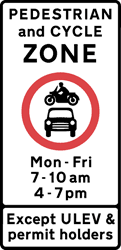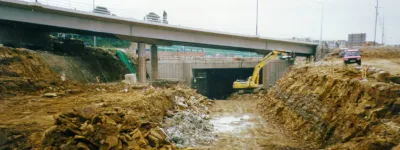London's Mayor, Sadiq Khan, introduced his new Toxicity Charge last year and hopes to cover much of London with a new Ultra Low Emission Zone from next year. Now three London boroughs are hoping to go even further, sooner.
There's no doubt that London's air quality is a problem, and over the last few years the issue has become increasingly political. This week, however, there was an interesting new development: three councils have set out their stall to beat the Mayor at his own game by setting up their own Ultra Low Emission Zones, and they're hoping to do it by the end of March this year.
What's being planned?
The boroughs of Hackney, Islington and Tower Hamlets - all inner London boroughs in north-east London, bordering the City - have joined forces on a project to improve air quality in the "city fringe", which roughly translates as the bit of London bordering the central area: the part that suffers a lot of the congestion of traffic on the Inner Ring Road and on key radial routes in and out, but doesn't get as much of the economic benefit as the central area itself.

The first proposal, now out for consultation, sits across the border of Islington and Hackney close to Old Street roundabout on the A501 Inner Ring Road. Two "zones" are proposed, divided by the Inner Ring Road: zone 1 covers Cowper, Singer, Tabernacle, Paul, Willow and Blackall Streets; zone 2 covers Rivington Street and Charlotte Road. These are narrow, minor streets, already mostly subject to one-way working and carrying relatively little through traffic. Lying between "Silicon Roundabout" and Shoreditch, they're in a trendy area known for its nightlife and a variety of building types and uses, with lots of pedestrian traffic.
If implemented, the Ultra Low Emission Zone would apply only on weekdays 7-10am and 4-7pm. It is actually, in a rather clever use of existing powers, a pedestrianisation project, and the signs at entry points will declare it a "pedestrian and cycle zone" with a "stunt motorbike" sign to prohibit all motorised vehicles. A supplementary plate below the sign will make an exception for permit holders (those being residents and businesses inside the zone who can apply to be exempted) and "ULEV" - ultra-low emission vehicles. The effect will be to ban all motorised traffic that does not belong to the people who live and work on those streets with the exception of fully electric vehicles and the very cleanest hybrids.
The zones will be enforced with Automatic Number Plate Recognition (ANPR) cameras, and steep fines of well over £100 will be issued to polluting vehicles that enter those streets during the hours of operation. Six such cameras will be required to police all entry points.
Will it last?
The immediate concern about a scheme like this is that it will come into force about a year before Sadiq Khan's Ultra Low Emission Zone, which will apply to the whole of London within the North and South Circular Roads, covering the whole of these very small zones. So will it have any purpose a year from now?
The answer is yes, because its requirements are more strict than the London-wide ULEZ. The scheme proposed by the three borough councils is designed to exclude virtually any vehicle that generates any sort of emissions, while the ULEZ itself will levy a daily charge (rather like the Congestion Charge) on vehicles that don't meet certain emissions standards. That will mean lots of petrol vehicles - and even some diesels - will be unaffected by the ULEZ but will still be banned from Cowper Street and Charlotte Road.
Will it make any difference?
That's rather harder to answer. The two zones that are proposed here are very small indeed, and are already carrying relatively low volumes of traffic compared to many other nearby roads. It's impossible to say, without access to more detailed figures than any of the councils have made available, what proportion of the vehicles using those streets in the rush hour belong to residents or traders, and without that information it's not at all clear how many vehicles will be deterred by the restrictions.
Possibly the greatest factor in air quality on all these streets is not the traffic that is on them but the traffic on the Inner Ring Road which passes between them. In recent years, Department for Transport figures show 30-35,000 vehicles a day use the road and they will continue, unaffected, when these new restrictions come into force.
In absolute terms, the number of people affected, the change to the traffic on these streets and the air quality around Old Street and Shoreditch will probably be little changed as a result of the Ultra Low Emission Streets scheme. It's likely that the scheme will have a more noticeable effect on rush hour rat-runners, snaking past the traffic jams on City Road and the Inner Ring Road, and that will have a knock-on effect on the desirability of driving to or through this part of London.
But probably the biggest effect of Hackney and Islington's experiment will be to see how the public react to the consultation and, assuming the two zones are implemented, how it affects people's lives and businesses there. If the two schemes are considered successful, they are almost certain to be the first of many little pocket-sized emissions bans: remember, this is a joint scheme between three borough councils, and they are undoubtedly thinking of applying similar regulations on much wider areas. And that will have an effect on air quality and on the number of people who are willing to commute or travel through the area by car. This is, remember, not the same as the Mayor's schemes, that allow anyone entry as long as they pay the price: in Hackney, Islington and Tower Hamlets, it's an outright ban, enforced by a fine, and the wealthy commuter in his Jaguar won't be able to buy his way in.
So this intriguing little experiment will be well worth keeping an eye on - not for the change in air quality it will achieve on its own, but for the effect it might have in planting the seed for large parts of Inner London north and east of the City going the same way in the next few years. And if you plan to continue travelling around Shoreditch and Limehouse by car in the coming years, it might be a good time to go electric.
Comments
Totally disagree it is gesture politics. It is almost certain that by 2030 almost all ICE vehicles will be banned from almost all urban streets. EVs will be prevalent and it will be socially unacceptable to have the levels of air pollution we do now past people's houses.
If some London boroughs want to get the good press first on something that isn't going to cost them any money than great. Probably attract some trendy start up businesses to the area as well.
Drivers should already be familiar with the pedestrian zone signage so zero sympathy for anyone who gets caught.
Can't wait until they roll them out here too!
Quite agree. Dinosaurs burning fossil fuels should be relegated to history. Londoners are less likely to have a petrol or Diesel engined car as a rule, so why should we suffer outsiders driving through and poisoning us?
Oh no no no... this is no innocent scheme. This is to only cause more difficulties to Londoners. They should just wait for the industry to change to electric - the current infrastructure isn't ready for electric cars yet anyway. Businesses will be NEGATIVELY affected - less people will now visit the shops in such a rubbish area.
"Silicone Roundabout" is a particularly unfortunate typo!
Oops - corrected now. Thank you!
" Londoners are less likely to have a petrol or Diesel engined car as a rule, so why should we suffer outsiders driving through and poisoning us?"
Londoners are less likely to have cars but it is the drivers from the semi detached suburbs and Home Counties who will be the buyers of electric vehicles as they have the private drives where they can charge them.
I like the idea, but enacting it via pedestrianisation seems to me to be a bad way to do it. It might make people regard the road as a pedestrian area, and may make accidents more common.
Add new comment
Sources
- City Fringe Ultra Low Emission Streets consultation, Hackney Borough Council.
Picture credits
- Picture of Rivington Street adapted from an original by Chris Whippet and used under this Creative Commons licence.
- Picture of drinking fountain on Tabernacle Street adapted from an original by Mike Faherty and used under this Creative Commons licence.



Typical "gesture politics" that will have no demonstrable effect on air quality whatsoever. Truly we live in a "ban it" society !!.